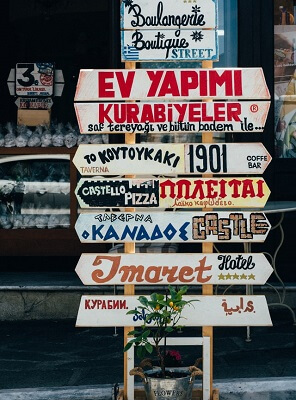So Many Choices! What Are the Best Languages to Learn?
There are over seven thousand languages spoken today. This is good news for the language-learning fanatic, who will never run out of new material with which to keep busy. But those of us with jobs, families, and hobbies must portion our free time carefully. Some languages are more popular than others, but there are no “best” languages to learn. Every learner must ask herself what she wants to get out of learning a new language, as the answer depends on the individual. For some, this is an easy question: they will move somewhere else and need to know the language, or they want to speak the language of their ancestors, or maybe they just like the sound of a particular language.
Thank you for reading this post, don't forget to subscribe!For others, choosing a language to learn can be a paralyzing question. The answer depends on much: what you want to accomplish, where you live now, where you want to live later, and much else besides. This blog post will look at the most popular languages and discuss why people choose to learn them.
A Few of the Most Popular Languages
If you want to learn a new language, then I commend you for that decision. Learning a new language—any language—will sharpen your mind and grant you a new skill. The list that follows discusses only some of the popular languages on Earth. The global use of a language might not be the best metric to decide what language you, yourself, should learn, but people who learn the following tongues have lots of company.
English
Starting the list is this no-brainer choice. While English does not have the highest population of first-language speakers, it swells its numbers with nearly a billion second-language speakers. The far-flung colonial efforts of Great Britain and the technological and economic superiority of the United States post–World War 2 put English in the forefront as the world entered the era of globalization. English became the language of international business and air travel, and it is so widespread that English travelers can make themselves understood just about anywhere.
Mandarin
Mandarin has everyone else beat in terms of native speakers, with nearly a billion speaking it as a first language. However, Mandarin is increasingly one of the languages people are flocking to for a second tongue, thanks to China’s bounding economy. An entrepreneur looking to expand his business internationally would do well to learn Mandarin, but beware! Mandarin is notoriously difficult for English speakers to grasp. For one, there is the Chinese writing system, which uses thousands of different symbols, as opposed to English’s 26 letters (although they don’t always correspond neatly to specific sounds). Another difficulty is the integral role tones play in Mandarin. Two words, spelled and pronounced identically but intoned differently, can have drastically different meanings. The scope for confusion and faux pas is enormous.
At least the grammar is simple: Mandarin learners won’t have to bother with verb conjugations and tenses, gendered nouns, and inflections (unlike Arabic, which is heavy on inflection).
Spanish
Much like English, the Spanish language owes much of its current popularity to colonial ambitions during the age of sail. Spanish is wildly popular; native Spanish speakers even outnumber native English speakers, though it is a less popular second-language choice as it doesn’t quite have English’s spread. That said, for people living in the United States, Spanish is one of the best languages to learn. About 35 million people in the United States speak Spanish; many learn the language in high school, and conscientious business people and tourists often learn Spanish before traveling to Mexico and the Spanish-speaking countries of South America.
There are many dialects of Spanish, but they are not as wildly different as the varieties of Arabic. Apart from some minor confusion caused by different vocabularies, two Spanish speakers will be able to hold a conversation no matter where they are from.
Arabic

But the “officialness” of a language is not all that important. (After all, English isn’t the official language of the United States or the United Kingdom.) People speak with people, not with countries, and Arabic-speaking people are found all over the world. Pretty much any decent-sized city will have a significant cluster of Arabic-speaking people, adding their distinctive flavor to the local culture. If you happen to live in such a city, you won’t have to look far to find an Arabic-speaking neighbor or a grocery store adorned with Arabic text. This widespread diaspora makes Arabic one of the most popular languages for people looking for a new tongue.
People with entrepreneurial spirits are increasingly setting their sights on the Middle East. The United Arab Emirates is famous for its international business ventures, though the entire Middle East as a whole is growing its economy rapidly. A quick web search is enough to confirm this: there are plenty of agencies dedicated to helping businesses contact and market to the Middle East, and blog posts about Middle Eastern business customs abound. Naturally, with this development comes a profusion of Arabic language courses.
How you go about learning Arabic depends on what you intend to do. Unlike Spanish, some varieties of Arabic are mutually unintelligible. An Arabic speaker from Morocco would have great difficulty speaking to someone from Saudi Arabia. For this reason, business-focused people are likely to study Modern Standard Arabic (MSA), which is widely understood throughout the Arabic-speaking world, allowing you to make contacts throughout the Middle East and North Africa. However, MSA is nobody’s native tongue. It is used by the media and as a common tongue by people who speak very different Arabic dialects.
For those looking to get to know the people and the culture of the Middle East, we recommend learning one of the natural dialects of Arabic. At Nasma, we believe that people learn to speak a culture as well as a language, which is why we focus on teaching conversational Levantine Arabic. Check out our podcasts, our YouTube channel, or our Instagram page for free Arabic tips. Then, if you’re feeling brave, you can go visit that little grocery store with the Arabic writing and greet the cashier with “marhaba.” After all, the best way to learn Arabic is by talking with someone.

